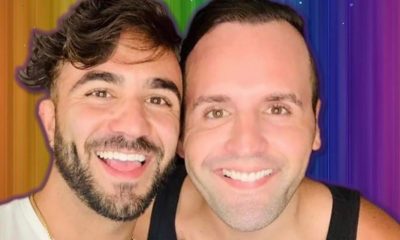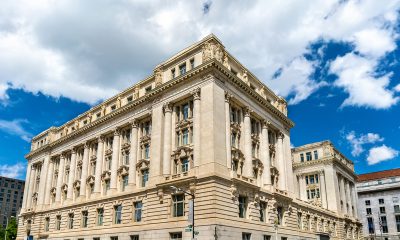Local
Suspected gunman worked for DC gay center
FBI has man in custody after incident at Family Research Council HQ
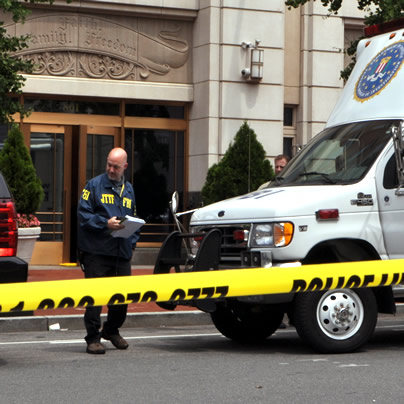
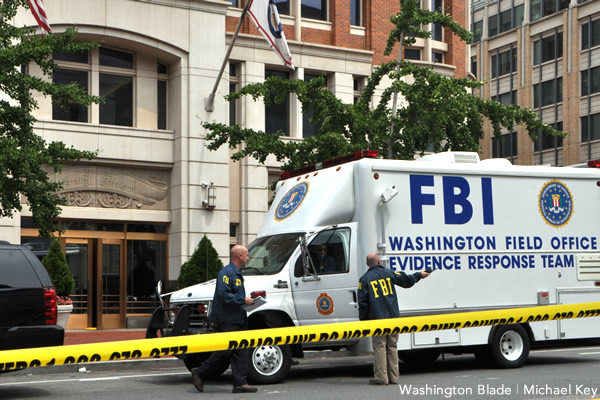
The Family Research Council headquarters building in Washington D.C. was cordoned off by police and the FBI Wednesday. (Washington Blade photo by Michael Key)
The suspect apprehended Wednesday morning for the shooting of a security guard in the lobby of the headquarters of the Family Research Council, one of the nation’s leading anti-gay groups, worked as a volunteer for the DC Center for the LGBT Community.
“We’re as surprised as everyone else,” DC Center President Michael Sessa told the Blade Wednesday night. “He volunteered for us.”
The Associated Press reported that a law enforcement official identified the suspect as Floyd Corkins II, 28, of Herndon, Va. The AP was the first to report that Corkins worked as a volunteer for the D.C. Center, but it didn’t disclose how it learned of Corkins’ association with the Center.
Sessa said the Center conducted a background check on Corkins.
Police and the FBI said a suspect shot the security guard in the arm about 10:50 a.m. Wednesday in the building’s lobby at 801 G St., N.W., which is located about a block from the Verizon Center. The guard, who suffered a non-life-threatening wound, was taken to a hospital for treatment, a police spokesperson said.
D.C. Police Chief Cathy Lanier and FBI Washington Field Office Director James McJunkin told reporters at a news briefing outside the building that the FBI took a male suspect into custody in connection with the case and had not charged him as of Wednesday afternoon.
The Washington Post reported that police and the FBI said they had yet to determine a motive for the shooting.
“We don’t know enough about him or his circumstances to determine what his connection is to this group or his mental state or what he was doing or thinking of doing,” the Post quoted McJunkin as saying. “So we’re going to try to sort this all out, pull the evidence together, do all the interviews we can,” the Post quoted McJunkin as saying.
Fox News reported an unidentified source familiar with the incident said the suspect “made statements regarding [the Family Research Council’s] polices and then opened fire with a gun striking the security guard.”
“He always struck me as kind, gentle and unassuming young man,” the AP quoted Center director David Mariner as saying. “I’m very surprised that he could be involved in something like this.”
According to the Post, McJunkin said the FBI became involved because of the possibility that the incident could be classified as a federal crime. The Post reported that as of early Wednesday, it was not clear whether D.C. police or the FBI would take the lead in the investigation.
D.C. police spokesperson Araz Alali told the Blade that the FBI became involved because the building in which the shooting occurred was federally owned. But the U.S. General Services Administration, which administers federal buildings, couldn’t immediately be reached to confirm whether the federal government owns or has an interest in the building.
A flag bearing the name of the Family Research Council hangs over the front of the building. The words “Faith, Family, Freedom” are inscribed in the building’s façade.
The Family Research Council and its executive director, Tony Perkins, have long denounced homosexuality as immoral and have linked it to pedophilia. The group has lobbied Congress and state legislatures in opposition to virtually all LGBT rights legislation.
The Southern Poverty Law Center, a nationally recognized civil rights group, has included FRC on its list of “hate groups,” saying it so classified the group because of its use of false and misleading information to defame LGBT people in a way that harms the LGBT community.
R. Clarke Cooper, executive director of the national gay group Log Cabin Republicans, released a statement condemning the shooting.
“As fellow conservatives, Log Cabin Republicans are often in the same room with the Family Research Council,” Cooper said. “Though we rarely see eye to eye, we absolutely condemn the violence that occurred today,” Cooper said.
“Keeping in mind that at this time we know little about the shooter or his motives, whatever our political disagreements, in this country, we use ballots, not bullets, to address them. We offer prayers for the injured security guard, his family, and everybody at the FRC building, barely a fifteen minute walk away from Log Cabin Republicans national headquarters,” Cooper said. “In many ways, this is a reminder that we aren’t so far apart.”
An FRC spokesperson couldn’t immediately be reached for comment.
The leaders of 40 LGBT advocacy organized issued a joint statement expressing sadness over the shooting incident at the Family Research Council building.
“Our hearts go out to the shooting victim, his family, and his co-workers,” the statement says. “The motivation and circumstances behind today’s tragedy are still unknown, but regardless of what emerges as the reason for this shooting, we utterly reject and condemn such violence. We wish for a swift and complete recovery for the victim of this terrible incident.”
Among those signing the statement were the heads of the Human Rights Campaign; National Gay and Lesbian Task Force; Parents, Families, and Friends of Lesbians and Gays; National Center for Transgender Equality; and the Gay and Lesbian Alliance Against Defamation, which released the statement on its letterhead. David Mariner, executive director of the D.C. LGBT Center, also signed the statement.
D.C. transgender activist Jeri Hughes said she, too, condemns the shooting incident at the FRC headquarters but asked why a half dozen or more FBI agents rushed to the scene of an incident that appeared to be a local law enforcement matter.
“I’d love to have the FBI investigate all the unsolved murders of the transgender women here in D.C. over the last several years,” Hughes said.
FBI spokesperson Jacqueline MaGuire told the Blade Wednesday night that the FBI and D.C. police were working with the U.S. Attorney’s office and an announcement would be made Thursday morning on a charge or charges expected to be filed against the suspect.
Virginia
Walkinshaw wins Democratic primary in Va. 11th Congressional District
Special election winner will succeed Gerry Connolly
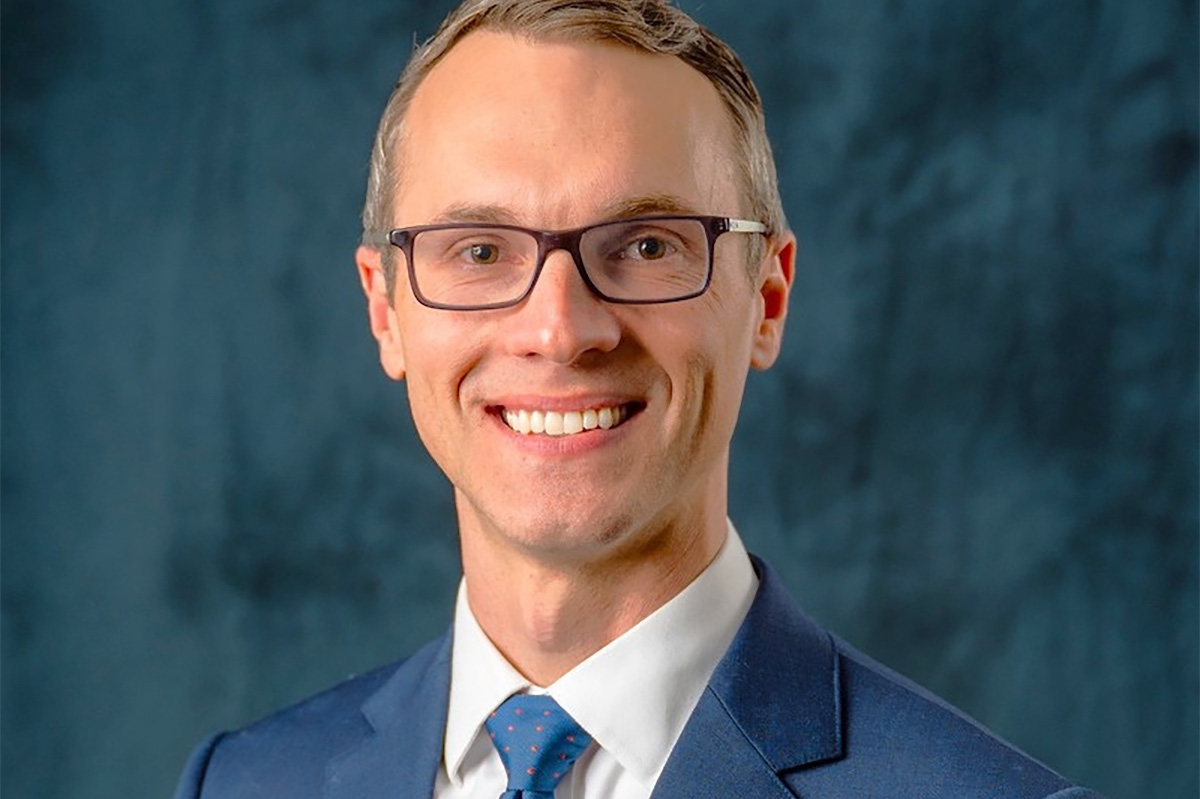
On Saturday, Fairfax County Supervisor James Walkinshaw won the Democratic primary for the special election that will determine who will represent Virginia’s 11th Congressional District.
The special election is being held following the death of the late Congressman Gerry Connolly, who represented the district from 2008 until 2024, when he announced his retirement, and subsequently passed away from cancer in May.
Walkinshaw is not unknown to Virginia’s 11th District — he has served on the Fairfax County Board of Supervisors since 2020 and had served as Connolly’s chief of staff from 2009 to 2019. Before he passed away, Connolly had endorsed Walkinshaw to take his place, claiming that choosing Walkinshaw to be his chief of staff was “one of the best decisions I ever made.”
The Democratic nominee has run his campaign on mitigating Trump’s “dangerous” agenda of dismantling the federal bureaucracy, which in the district is a major issue as many of the district’s residents are federal employees and contractors.
“I’m honored and humbled to have earned the Democratic nomination for the district I’ve spent my career serving,” Walkinshaw said on X. “This victory was powered by neighbors, volunteers, and supporters who believe in protecting our democracy, defending our freedoms, and delivering for working families.”
In addition to protecting federal workers, Walkinshaw has a long list of progressive priorities — some of which include creating affordable housing, reducing gun violence, expanding immigrant protections, and “advancing equality for all” by adding sexual orientation and gender identity to the Fair Housing Act.
Various democratic PACs contributed more than $2 million to Walkinshaw’s ad campaigns, much of which touted his connection to Connolly.
Walkinshaw will face Republican Stewart Whitson in the special election in September, where he is the likely favorite to win.
Maryland
LGBTQ suicide prevention hotline option is going away. Here’s where else to go in Md.
Changes will take effect July 17
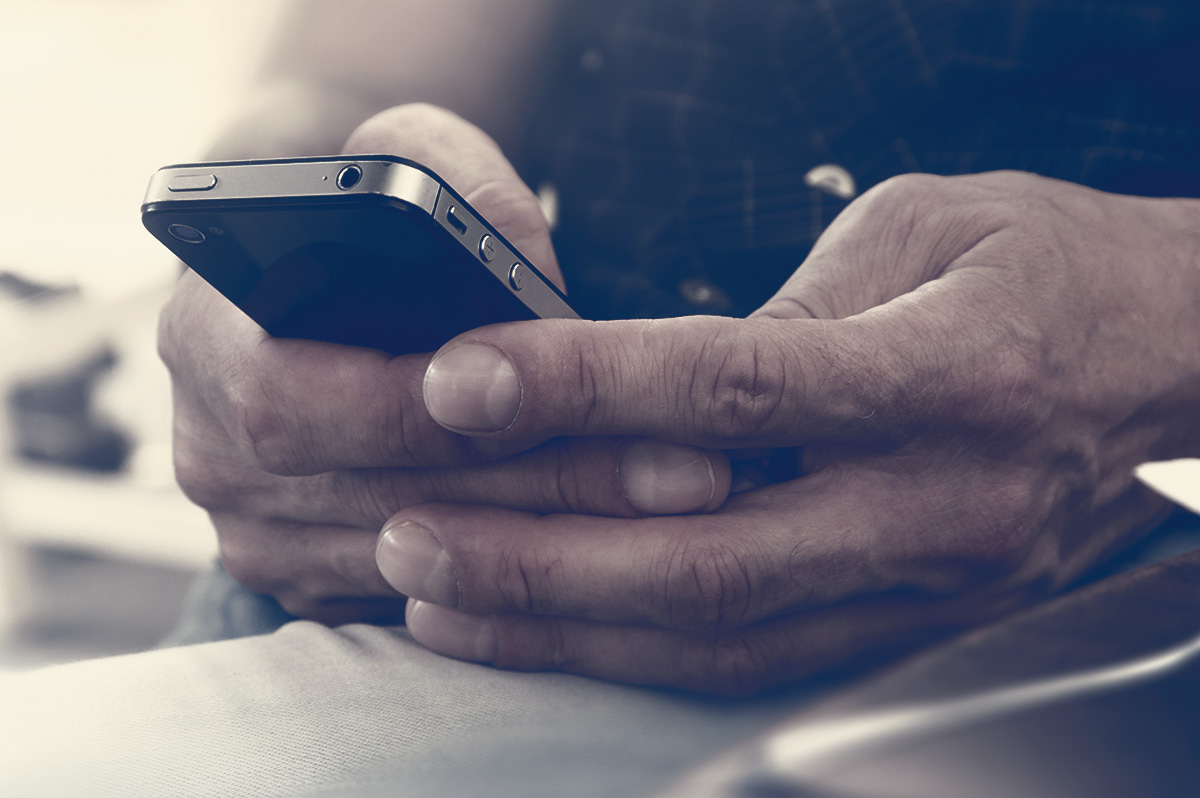
By ANNA RUBENSTEIN | The national suicide prevention hotline will no longer offer specialized support to LGBTQ people, starting July 17, the Trump administration announced last week.
Dialing the hotline at 988 will still be available for crisis support. But callers will no longer be able to reach specific LGBTQ services by pressing Option 3. The change worries advocates because their data shows the LGBTQ community has a disproportionally high suicide rate.
Even after the option ends, here’s how to receive tailored support if you’re in Maryland.
The rest of this article can be found on the Baltimore Banner’s website.
Maryland
Silver Spring holds annual Pride In The Plaza
‘Today means inclusion. It means to build resilience’
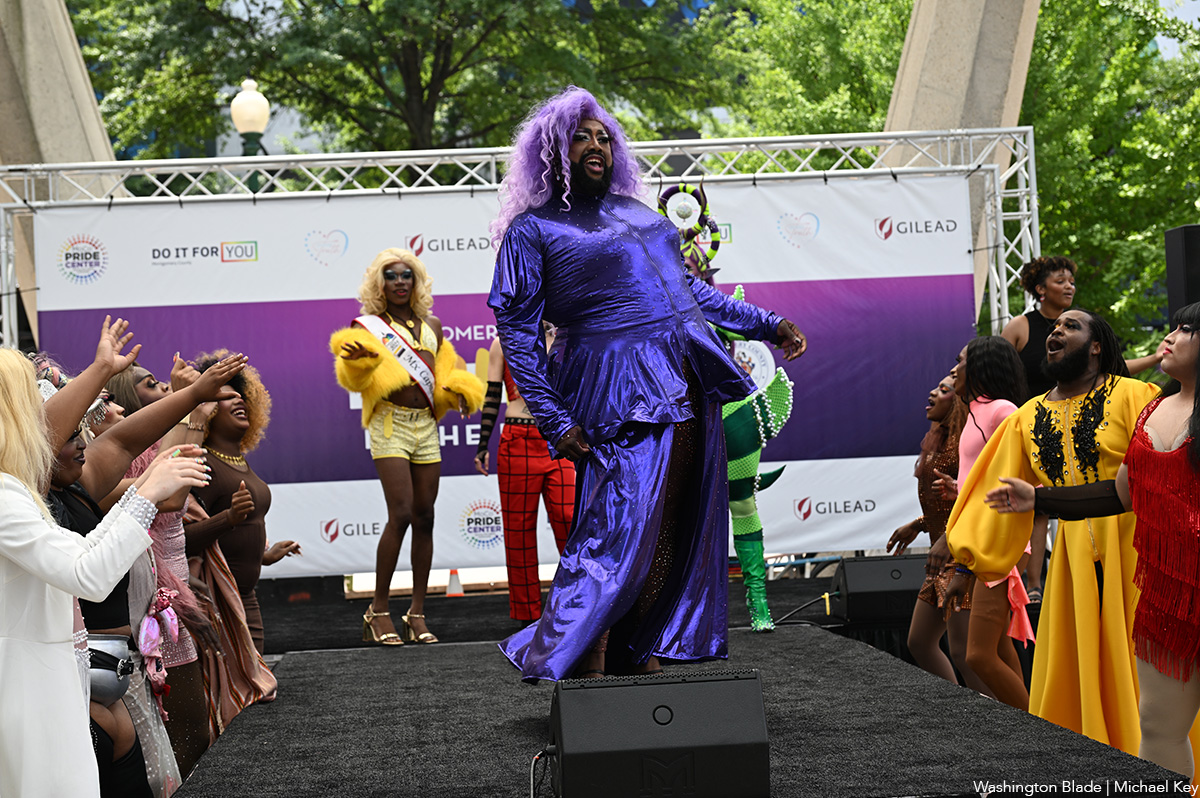
Silver Spring’s annual Pride in the Plaza event took place on Sunday to celebrate the LGBTQ community and emphasize inclusion and resilience.
“Today means inclusion. It means to build resilience, love,” Robyn Woods, program and outreach director for Live In Your Truth, which organized the event, said. “I mean, just being surrounded by the community and so many great entrepreneurs, business owners, and just being a part of this whole rainbow coalition that we call the LGBTQIA to be about.”
With the event being her first time organizing for Live In Your Truth, Woods said she felt emotional to see the support and love at the event.
“Some people (are) bringing out their children, their babies, their grandparents,” Woods said. “It’s a lot more allies here than anything else. That type of support to me means so much more than just support from my community; just outside support, inside support, so much support around it, so much love. Everyone’s smiling outside, helping each other.”
Attendees of the event were able to head over to the Family Fun Zone, an air-conditioned Pride Cool Down Lounge, or watch live drag performances in the main stage area.
Along with entertainment and a shaved-ice stand, rows of information tables stood along the plaza, including FreeState Justice, the Washington Spirit, Trans Maryland, Moco Pride Center, and the Heartwood Program, an organization that offers support, therapy, education, and resources to the LGBTQ community.
“I want people to know about our services, and I love what we have to offer,” Jessica Simon, psychotherapist for Heartwood Program’s Gender Wellness Clinic, said. “I (also) want to be part of a celebration with the community, and so it feels good to be here with other people who have something they want to give to the community.”
She added that within today’s political climate, to which she called an “antidote to shame,” it’s important to be celebrating Pride.
“There’s a lot of demonization of LGBTQI people,” Siena Iacuvazzi, facilitator for Maryland Trans Unity, said. “(Pride) is part of the healing process.”
Iacuvazzi said she was taught to be ashamed of who she was growing up, but being a part of a community helped her flourish in the future.
“I was taught how to hate myself. I was taught that I was an abomination to God,” she said. “But being a community is like understanding that there are people who have experienced the same thing, and they’re flourishing. They’re flourishing because they’re willing to stand up for themselves as human beings and discover themselves and understand what’s true for themselves.”
She added that Pride allows for a mutual understanding to take place.
“It’s more of a sense of belonging … and just taking that home and understanding you’re not alone,” Iacuvazzi said. “We’re each taking our own journey — we’re not putting that on each other. It’s just walking away with a sense of belonging and humanity.”
Similar to Iacuvazzi, Woods said she hopes attendees’ biggest takeaways would be family, fun, resilience, and pride.
“Being proud of yourself, being happy for who you are, and representation and how much it matters,” she continued. “And I think all these young people that are walking around here get to see versions of themselves, but older. They get to see so many different lesbian, gay, bisexual, pansexual people that are successful, that are showing love, that care, and it’s not how we’re portrayed in the media. It’s lovely to see it out here. (It’s) like we’re one big old, happy family.”
-

 U.S. Supreme Court4 days ago
U.S. Supreme Court4 days agoSupreme Court upholds ACA rule that makes PrEP, other preventative care free
-

 U.S. Supreme Court4 days ago
U.S. Supreme Court4 days agoSupreme Court rules parents must have option to opt children out of LGBTQ-specific lessons
-

 Television5 days ago
Television5 days ago‘White Lotus,’ ‘Severance,’ ‘Andor’ lead Dorian TV Awards noms
-
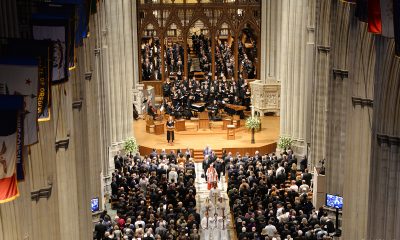
 Music & Concerts5 days ago
Music & Concerts5 days agoBerkshire Choral to commemorate Matthew Shepard’s life



